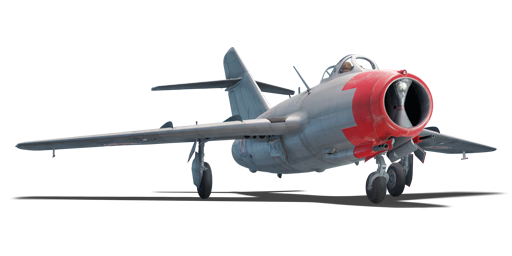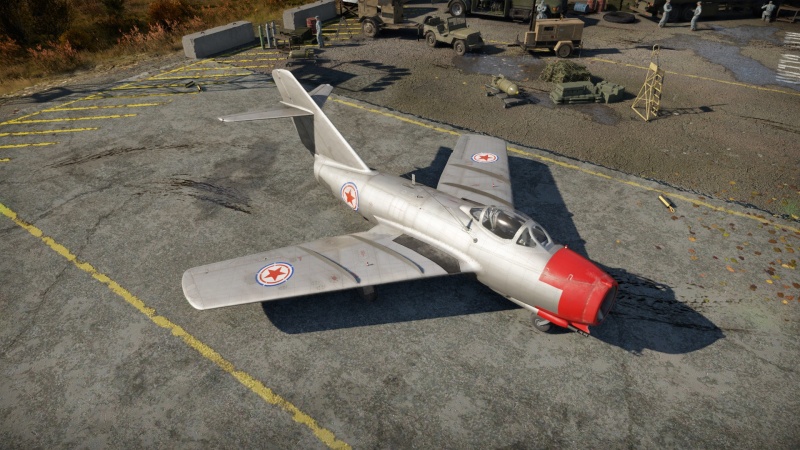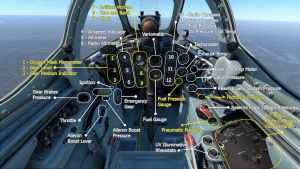Difference between revisions of "MiG-15bis"
m (→General info: Added a cockpit image) |
m (→General info) |
||
| Line 18: | Line 18: | ||
== General info == | == General info == | ||
| − | [[File:CockpitImage_MiG-15.jpg|thumbnail|right|The '''MiG-15bis'''' | + | [[File:CockpitImage_MiG-15.jpg|thumbnail|right|The '''MiG-15bis'''' instrument panel.]] |
=== Flight performance === | === Flight performance === | ||
Revision as of 18:52, 23 February 2021
| This page is about the Russian jet fighter MiG-15bis. For other versions, see MiG-15 (Family). |
Contents
Description
The MiG-15bis is a rank V Russian jet fighter with a battle rating of 8.7 (AB/SB) and 8.3 (RB). It has been in the game since the start of the Open Beta Test prior to Update 1.27.
The Mikoyan-Gurevich MiG-15bis is an upgraded variant of the MiG-15 jet fighter. It utilises an improved version of the RD-45 (imported British Rolls–Royce Nene) turbojet engine, the Klimov VK-1, for increased performance. The MiG-15bis also has better ground attack capability with underwing hardpoints for bombs and rockets.
In-game, the MiG-15bis fulfils the same role as the MiG-15, primarily serving as an air superiority fighter and bomber interceptor. It is blessed with excellent high-altitude performance and powerful armament, but suffers from controllability problems at high Mach numbers. It excels in vertical combat manoeuvres, taking advantage of its high thrust-to-weight ratio. The MiG-15bis also has a limited ground attack capability.
General info
Flight performance
The MiG-15bis is an improved and definitive MiG-15 version, the main difference is the improved engine, the Klimov VK-1. Its level speed at sea level was increased by 26 km/h to 1076 km/h, but it is still lower than many other jets like for example the F-86 series. The other noticeable change is a huge improvement of thrust-to-weight ratio which increased the acceleration by ~10% and it also has a huge impact on its climb rate, it can reach up to 50 m/s at low altitude with full fuel tanks, making the MiG-15bis one of the best climbing planes compared to other planes at similar battle rating. Like the previous version, it can not fly at max power for too long or it will start overheating. While decreasing the power to 95% or lower will cool it down for a moment, if you increase it back to 100% it will immediately start overheating again.
The manoeuvrability compared to the previous variant is basically the same, while this version is slightly worse at performing horizontal manoeuvres due to increased weight (by ~100 kg), it is now better at performing vertical loop and other similar manoeuvres because of the better engine. It should be able to deal with ease with any other jet fighter like the F-86, Super Mystère or Hunter F.1 in any dogfight scenario. The last change that can be noticed is its roll rate, which is overall better now. At high speed, it does not suffer as much from compressibility but it is still at best mediocre. The elevator and rudder controls remained the same, so the plane still locks up a lot after reaching subsonic speeds. Other features stayed the same: airbrakes help with slowing the plane down when it locks up too much and flaps help significantly increase dogfighting capability at low and medium speeds.
In simulator battles the plane is not hard to fly, while it can be stalled out even at high speed the stalling characteristics are not too violent and it can be easily recovered from any spin or when it is stalled out. The elevator trimming is not required. Its improved roll rate makes it more pleasant to fly, using the rudder to improve it is not that much required in combat situations anymore.
| Characteristics | Max Speed (km/h at 0 m - sea level) |
Max altitude (metres) |
Turn time (seconds) |
Rate of climb (metres/second) |
Take-off run (metres) | |||
|---|---|---|---|---|---|---|---|---|
| AB | RB | AB | RB | AB | RB | |||
| Stock | 1,062 | 1,046 | 15500 | 21.0 | 22.0 | 41.4 | 39.8 | 475 |
| Upgraded | 1,087 | 1,076 | 20.4 | 20.7 | 59.7 | 50.0 | ||
Details
| Features | |||||
|---|---|---|---|---|---|
| Combat flaps | Take-off flaps | Landing flaps | Air brakes | Arrestor gear | Drogue chute |
| X | ✓ | ✓ | ✓ | X | X |
| Limits | ||||||
|---|---|---|---|---|---|---|
| Wings (km/h) | Gear (km/h) | Flaps (km/h) | Max Static G | |||
| Combat | Take-off | Landing | + | - | ||
| 0 | 450 | N/A | 598 | 450 | ~12 | ~7 |
| Optimal velocities (km/h) | |||
|---|---|---|---|
| Ailerons | Rudder | Elevators | Radiator |
| < 600 | < 700 | < 750 | N/A |
Engine performance
| Engine | Aircraft mass | |||||
|---|---|---|---|---|---|---|
| Engine name | Number | Empty mass | Wing loading (full fuel) | |||
| Klimov VK-1 | 1 | 3,648 kg | 233 kg/m2 | |||
| Engine characteristics | Mass with fuel (no weapons load) | Max Takeoff Weight | ||||
| Weight (each) | Type | 8m fuel | 20m fuel | 28m fuel | ||
| 892 kg | Centrifugal-flow turbojet | 3,980 kg | 4,478 kg | 4,810 kg | 5,485 kg | |
| Maximum engine thrust @ 0 m (RB / SB) | Thrust to weight ratio @ 0 m (100%) | |||||
| Condition | 100% | WEP | 8m fuel | 20m fuel | 28m fuel | MTOW |
| Stationary | 2,450 kgf | N/A | 0.62 | 0.55 | 0.51 | 0.45 |
| Optimal | 2,450 kgf (0 km/h) |
N/A | 0.62 | 0.55 | 0.51 | 0.45 |
Survivability and armour
- 10 mm steel armour plates in front of the cockpit and behind the pilot's head rest.
- 6 mm steel armour under the pilot's seat.
- 64 mm bulletproof front windshield.
- Self-sealing fuel tanks behind the pilot and under the jet engine nozzle.
- Jet engine located in the rear of the aircraft, pilot seated in front.
Modifications and economy
It is recommended to obtain the modifications in the following order:
Compressor>New boosters>Offensive 37mm>Wings repair>Engine>G-suit>New 37mm cannons>Cover>Offensive 23mm>New 23mm cannons>Airframe>Fuselage repair>Suspended weapons
Armaments
Offensive armament
The MiG-15bis is armed with:
- 1 x 37 mm N-37D cannon, chin-mounted (40 rpg)
- 2 x 23 mm NR-23 cannons, chin-mounted (80 rpg = 160 total)
In line with its originally designed role of bomber interception, the MiG-15bis is armed with three powerful nose-mounted autocannons. The 37 mm N-37D cannon is particularly noteworthy, as even a small number of hits are usually fatal to any aircraft unfortunate enough to be on the receiving end, with the twin 23 mm NR-23 cannons also being quite respectable in terms of lethality.
The trade-off is that these cannons do not have large ammunition reserves, especially compared to the American planes armed with heavy machine guns, and it is very easy to run out of ammunition without careful aim. In addition, the N-37D has a significantly lower muzzle velocity than the NR-23, with a more pronounced ballistic arc. This makes obtaining hits with both types of cannon at the same time quite challenging; using only the 37 mm or the 23 mm cannons at one time may be more efficient with regards to ammunition usage.
Suspended armament
The MiG-15bis can be outfitted with the following ordnance:
- Without load
- 2 x 100 kg FAB-100M-43 bombs (200 kg total)
- 2 x 250 kg FAB-250M-46 bombs (500 kg total)
- 16 x S-5K rockets
- 16 x S-5M rockets
- 2 x S-21 rockets
The MiG-15bis is capable of carrying up to 500 kg of bombs on underwing hardpoints. While this pales in comparison to the American or British fighter-bombers, it is enough for taking out isolated ground targets, if needed.
The S-5M HE rockets are most effective against light ground units, while the S-5K HEAT rockets are capable of penetrating the top armour of most vehicles.
The massive S-21 rocket has a considerable blast radius, and a single hit on a tank is usually fatal. The rocket may also be set with a distance fuse (up to 1,000 m), which can be very effective against large aircraft, such as bombers, or tightly bunched groups of smaller aircraft.
Usage in battles
The MiG-15bis is very similar to the MiG-15 and should be played as you would that aircraft, using boom-and-zoom style attacks and keeping your energy high - speed is life in jet battles. It wouldn't be a bad idea to try head-ons if you know what you are doing. The 37 mm and 23 mm combo really help. The plane lacks in roll rate so you will have to watch out for other jets trying to reverse you.
Pros and cons
Pros:
- Excellent climb rate and acceleration.
- Above average manoeuvrability.
- Powerful main armament, especially effective against bombers.
- Ability to carry massive S-21 rockets, unlike the earlier MiG-15.
- Amazing turn <800 km/h (520 mph)
Cons:
- Somewhat slow roll rate.
- Poor controllability due to compression at high Mach numbers (> Mach 0.9).
- Inhomogeneous main armament with different ballistic characteristics can make aiming difficult.
- Limited ammunition capacity.
- With stock guns and belts, they are very inaccurate and tend to spark a lot.
- Poor forward visibility in simulator, as a large canopy frame and the gunsight block the top and bottom
History
Describe the history of the creation and combat usage of the aircraft in more detail than in the introduction. If the historical reference turns out to be too long, take it to a separate article, taking a link to the article about the vehicle and adding a block "/History" (example: https://wiki.warthunder.com/(Vehicle-name)/History) and add a link to it here using the main template. Be sure to reference text and sources by using <ref></ref>, as well as adding them at the end of the article with <references />. This section may also include the vehicle's dev blog entry (if applicable) and the in-game encyclopedia description (under === In-game description ===, also if applicable).
In-game description
After World War II was over, the leaders of the USSR realized that they were behind the leading states of the world in the sphere of jet aircraft construction, most notably in the full-scale production of turbojet engines. Consequently, a delegation including the designers A. I. Mikoyan and V. Y. Klimov was sent to Great Britain towards the end of 1946. Their negotiations were successful, resulting in the purchase of two of the most advanced turbojet engines at that time: the Rolls-Royce Derwent Mk.V and the Rolls-Royce Nene I/Nene II. The British consented to sell their newest strategic designs easily enough, since they believed that the Soviet industrial/technological apparatus could not handle the mass production of sophisticated assemblies. However, very soon that the Rolls-Royce engines were launched into full-scale Soviet production under the designations RD-500 and RD-45.
The emergence of the new engines led to the creation of Soviet jet fighters able to compete with the leading models of the world. In 1947, the Mikoyan Design Bureau started the development of a front line fighter with a Nene (RD-45) turbojet engine and an airtight cockpit: the I-310 ("S"). The first S-01 prototype aircraft made its first flight on December 30, 1947, and, after working on the test results, was launched into full-scale production in 1948 under the designation MiG-15. The plane's airframe was an all-metal monoplane configuration with mid-swept wings and empennage. Thus the MiG-15 became the first production swept-wing fighter.
The MiG-15 was equipped with a RD-45F single-shaft turbojet engine rated at 2,270 kg of thrust with a double-entry centrifugal compressor. The plane's armament included a 37mm Nudelman N-37D cannon with 40 rounds and two 23mm Nudelman-Suranov NS-23KM guns with 160 rounds in total. The cannons were mounted in the forward fuselage on a lowerable carriage. Two 100-kg or 50-kg bombs could be suspended under the wings. To increase its flight range, the aircraft could carry two external fuel tanks with a capacity ranging from 250 to 600 litres.
The MiG-15 fighter was notable for its simple and reliable structure, high flight and operating characteristics, and powerful armament. Its maximum speed, rate of climb, ceiling, and flight range were the best among Soviet fighters at the time and superior to many foreign aircraft, as well.
The first production MiG-15s with RD-45F engines began to leave the factory floor in early 1949. In 1950, more advanced MiG-15bis fighters replaced them in the factory assembly lines.
Media
Excellent additions to the article would be video guides, screenshots from the game, and photos.
See also
Links to the articles on the War Thunder Wiki that you think will be useful for the reader, for example:
- reference to the series of the aircraft;
- links to approximate analogues of other nations and research trees.
External links
| Mikoyan-Gurevich Design Bureau (Микоя́н и Гуре́вич Опытное конструкторское бюро) | |
|---|---|
| Fighters | MiG-3-15 · MiG-3-15 (BK) · MiG-3-34 |
| I-225 | |
| Jet fighters | MiG-9 · MiG-9 (l) |
| MiG-15 · MiG-15bis · MiG-15bis ISh | |
| MiG-17 | |
| MiG-19PT | |
| MiG-21F-13 · MiG-21PFM · MiG-21S (R-13-300) · MiG-21SMT · MiG-21bis | |
| MiG-23M · MiG-23ML · MiG-23MLD | |
| MiG-27M · MiG-27K | |
| MiG-29 · MiG-29SMT | |
| Export/Licensed | ␗MiG-9 · ␗MiG-9 (l) |
| ◊MiG-15bis · ◔MiG-15bis · J-2* | |
| MiG-17AS · ◔MiG-17PF · J-4* · Shenyang F-5* | |
| ◊MiG-19S · J-6A* | |
| ◄MiG-21 SPS-K · ◊MiG-21MF · ◔MiG-21MF · ▄MiG-21bis · ◔MiG-21bis-SAU · ◊MiG-21bis-SAU · ◊MiG-21 "Lazur-M" · ▄MiG-21 Bison · J-7II** | |
| ◊MiG-23BN · ◊MiG-23MF · ◔MiG-23MF · ◊MiG-23MLA | |
| ◔MiG-29 · ◊MiG-29 · ◄MiG-29G | |
| *Licensed and domesticated with Chinese designations. | |
| **Unlicensed, reverse-engineered and domesticated with Chinese designations. | |
| See Also | Shenyang · Chengdu |
| USSR jet aircraft | |
|---|---|
| Bereznyak-Isayev | BI |
| Yakovlev | Yak-15 · Yak-15P · Yak-17 · Yak-23 · Yak-28B · Yak-30D · Yak-38 · Yak-38M · Yak-141 |
| Mikoyan-Gurevich | MiG-9 · MiG-9 (l) · MiG-15 · MiG-15bis · MiG-15bis ISh · MiG-17 · MiG-17AS · MiG-19PT |
| MiG-21F-13 · MiG-21PFM · MiG-21S (R-13-300) · MiG-21SMT · MiG-21bis | |
| MiG-23M · MiG-23ML · MiG-23MLD · MiG-27M · MiG-27K | |
| MiG-29 · MiG-29SMT | |
| Lavochkin | La-174 · La-15 · La-200 |
| Sukhoi | Su-9 · Su-11 |
| Su-7B · Su-7BKL · Su-7BMK · Su-17M2 · Su-17M4 · Su-22M3 | |
| Su-24M | |
| Su-25 · Su-25BM · Su-25K · Su-25T · Su-25SM3 · Su-39 | |
| Su-27 · Su-27SM | |
| Su-34 | |
| Ilyushin | IL-28 · IL-28Sh |
| Tupolev | Tu-14T |






